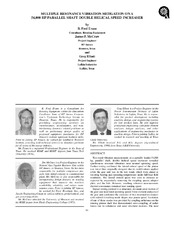| dc.description.abstract | Test stand vibration measurements on a partially loaded 54,000 hp, parallel shaft, double helical speed increaser revealed synchronous resonant vibrations near normal operating speed. Further testing confirmed the lateral critical speed of the pinion was lower than originally designed due to modifications applied while the gear unit was in the test stand, which were aimed at lowering bearing pad operating temperatures under full load field conditions. The lateral critical speed was seen to increase as expected by sequentially removing the coupling spacer, adapter plate, and the hub. However, resulting vibration measurements showed a resonance remained near running speed. Impact testing pointed to a structural, resonant axial motion of the gear case near rated operating speed. Finite element analyses of the gear unit confirmed the existence of two structural resonances with endwall breathing mode shapes near pinion speed. Excitation of one of these modes was provided by coupling unbalance on the rotating pinion shaft that demonstrated cross-coupling of radial forces due to unbalance and axial structural motions. The near coincidence of the structural resonance and the lateral critical speed on the test stand provided vibration amplification above that normally expected due to either resonant condition alone. Amplification factors were moderate and significant overlap occurred between the flanks of the two resonances. A two-step solution was implemented to increase the resonant frequencies of both the shaft in its oil film bearings and the gear case end walls. First, a bearing clearance and preload modification were applied along with additional hot oil removal techniques. Second, a tie bar brace was added above and parallel to the pinion between the end walls of the upper section of the gear case to increase structural stiffness in an axial direction. Additional rotordynamic and finite element analyses predicted significantly improved response to unbalance. The bearing and structural modifications were installed and tested sequentially. These tests, under similar conditions as previously imposed on the unit for qualification and acceptance, were successful in proving the solution. This paper documents measured vibrations at various stages in the investigation, results of rotordynamic and finite element analyses, bearing and gear case modifications, and final successful tests. | en |


